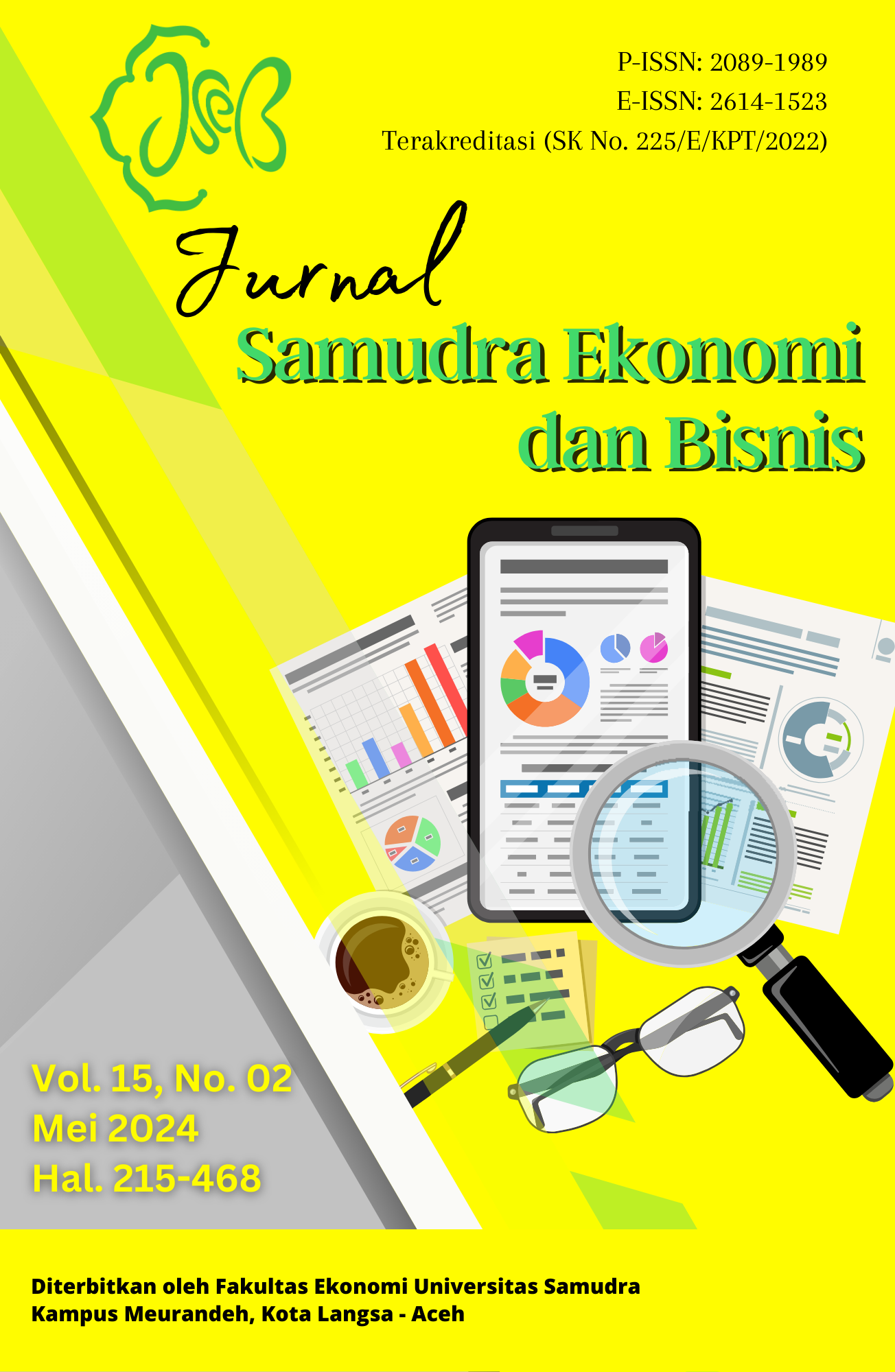Determinan Kemiskinan di Wilayah Metropolitan “Kedungsepur” Jawa Tengah
Abstract
The study aims to examine the influence of several economic factors on poverty levels in the Kedungsepur metropolitan area. Factors analyzed include the unemployment rate, average years of schooling, and per capita expenditure. By using E-Views 9 software to process statistical data, panel data regression analysis has been carried out with the preferred common effect model. The results show that both the unemployment rate and the average number of years of schooling have a positive relationship with the poverty rate in Kedungsepur. On the other hand, per capita expenditure has a negative effect on poverty levels. These findings indicate that local governments need to focus more efforts on increasing access to quality education and increasing people's purchasing power to effectively reduce poverty in the region.
References
Adams Jr, R. H. (2004). Economic growth, inequality and poverty: Estimating the growth elasticity of poverty. World Development, 32(12), 1989–2014. https://doi.org/10.1016/j.worlddev.2004.08.006.
Adisasmita, R. (2013). Analisis faktor-faktor yang mempengaruhi kemiskinan di Indonesia. Jurnal Bisnis Dan Ekonomi (JBE), 20(1), 67–77. http://dx.doi.org/10.15408/ess.v4i2.1966.
Amalia, F. (2017). Pengaruh pendidikan, pengangguran dan inflasi terhadap tingkat kemiskinan di kawasan timur Indonesia (KTI) periode 2001-2010. Jurnal Ilmiah Econosains, 10(2), 158-169. https://doi.org/10.21009/econosains.0102.02.
Amir, P., Ullah, I., & Yasin, H. M. (2018). Unemployment and poverty in Pakistan: A cointegrational analysis. International Journal of Social Economics, 24(20), 1-17. http://dx.doi.org/10.1177/0972150920920440.
Andhykha, R., Handayani, R. H., & Woyanti, N. (2018). Analisis pengaruh PDRB, tingkat pengangguran, dan IPM terhadap tingkat kemiskinan di Provinsi Jawa Tengah. Media Ekonomi dan Manajemen, 33(2), 113-123. http://dx.doi.org/10.24856/mem.v33i2.671.
Astuti, N. K. R., & Gunastri, N. M. (2017). Strategi pemberdayaan ekonomi rakyat dalam penanggulangan kemiskinan di Indonesia. Forum Manajemen STIMI Handayani, 12, 38–53. http://ojs.stimihandayani.ac.id/index.php/FM/article/download/83/49.
Bahmani-Oskooee, M., & Nasir, A. B. M. (2004). ARDL approach to test the productivity bias hypothesis. Review of Development Economics, 8(3), 483–488. http://dx.doi.org/10.1111/j.1467-9361.2004.00247.x.
Bank, W. (2015). Ending extreme poverty and sharing prosperity: Progress and policies. The World Bank Annual Report 2010. World Bank Group. https://www.worldbank.org/en/about/annual-report-2015.
Bintang, A. B. M., & Woyanti, N. (2018). Pengaruh PDRB, pendidikan, kesehatan, dan pengangguran terhadap tingkat kemiskinan di Jawa Tengah (2011-2015). Media Ekonomi Dan Manajemen, 33(1), 20–28. https://doi.org/10.24856/mem.v33i1.563.
BPS. (2021). Persentase penduduk miskin menurut provinsi. Berita Resmi Statistik. Badan Pusat Statistik. https://www.bps.go.id/.
BPS. (2022). Kemiskinan dan ketimpangan. Berita Resmi Statistik. Badan Pusat Statistik. https://www.bps.go.id/.
BPS. (2023). Kemiskinan dan ketimpangan. Berita Resmi Statistik. Badan Pusat Statistik. https://www.bps.go.id/.
Brooks, C. (2014). Introductory econometrics for finance (3rd ed.). Cambridge University Press. https://doi.org/10.1017/CBO9781139540872.
Edy, C. (2017). Pengaruh pendidikan terhadap tingkat kemiskinan masyarakat di Provinsi Banten. MIMBAR: Jurnal Sosial Dan Pembangunan, 33(1). https://doi.org/10.29313/mimbar.v33i2.2330.
Galbraith, J. K. (1979). The nature of mass poverty. Harvard University Press.
Ghozali, I. (2011). Aplikasi analisis multivariate dengan program IMB SPSS 19. Badan Penerbit Universitas Diponegoro.
Giovanni, R. (2018). Analisis pengaruh PDRB, pengangguran dan pendidikan terhadap tingkat kemiskinan di Pulau Jawa tahun 2009-2016. Economics Development Analysis Journal, 7(1), 23–31. https://doi.org/10.15294/edaj.v7i1.21922.
Gujarati, D. N. (2009). Basic econometrics. McGraw-Hill Education.
Hannum, E., & Buchmann, C. (2005). Global educational expansion and socio-economic development: An assessment of findings from the social sciences. World Development, 33(3), 333–354. http://dx.doi.org/10.1016/j.worlddev.2004.10.001.
Heny, M., & Dewi, U. (2013). IPM terhadap jumlah penduduk miskin di Provinsi Bali tahun 2004 – 2013. E-Jurnal Ekonomi Pembangunan Universitas Udayana, 5(7), 861–881. https://ojs.unud.ac.id/index.php/eep/article/view/22752.
Hsiao, C. (2014). Analysis of panel data (3rd edition). Cambridge University Press.
Husaini, A., & Sudirman, I. W. (2017). Analisis faktor-faktor yang mempengaruhi tingkat kemiskinan di Indonesia. Jurnal Ekonomi Dan Studi Pembangunan, 9(1), 33-46. https://doi.org/10.22219/jep.v10i1.3714.
Kevin, A. V., Bhinadi, A., & Syari’udin, A. (2022). Pengaruh PDRB, angka harapan hidup, dan rata rata lama sekolah terhadap kemiskinan di Kabupaten/Kota Provinsi Jawa Tengah tahun 2013-2021. SIBATIK JOURNAL: Jurnal Ilmiah Bidang Sosial, Ekonomi, Budaya, Teknologi, Dan Pendidikan, 1(12), 2959–2968. https://doi.org/10.54443/sibatik.v1i12.482.
Keynes, J. M. (1936). The general theory of employment, interest and money. Macmillan. https://ideas.repec.org/b/pal/palbok/978-1-349-59072-8.
Keynes, J. M. (1931). Essays in persuasion. MacMillan. https://ideas.repec.org/b/pal/palbok/978-1-349-59072-8.
Magrini, E. (2007). Analysing convergence through the distribution dynamics approach: Why and how?. Journal of Economic Surveys, 21(1), 243–265. http://dx.doi.org/10.2139/ssrn.1011946.
Mehta, A. C. (2005). Elementary education in unrecognized schools in India: A study on Rajasthan. National Institute of Educational Planning and Administration. Publication Unit NIEPA, New Delhi. https://righttoeducation.in/sites/default/files/UnRecPunjab05.pdf.
Muslim, M. (2014). Pengangguran terbuka dan determinannya. Jurnal Ekonomi Dan Studi Pembangunan, 15(2), 171–181. http://journal.umy.ac.id/index.php/esp/article/download/1234/1292.
Napitulu S. A. (2007). Pengaruh indikator komposit indeks pembangunan manusia terhadap penurunan jumlah penduduk miskin di Sumatera Utara. Skripsi. Universitas Sumatera Utara. http://repository.usu.ac.id/bitstream/123456789/9865/1/030501027.pdf.
Nurkse, R. (1953). Problems of capital formation in underdeveloped countries. Basil Blackwell.
Nurmasyitah & Mislinawati. (2017). Upaya pemerintah dalam menanggulangi kemiskinan. Jurnal Pesona Dasar, 1(5), 30–36. https://jurnal.usk.ac.id/PEAR.
Okun, & Arthur, M. (1962). Potential GN: Its Measurement and Significance dalam buku Proceedings of The Business and Economic Statistic Section. (pp. 98-103).Washington: America Statistical Association. http://dx.doi.org/10.1057/978-1-349-95121-5_2346-1.
Okun, A. M. (1962). Potential GNP: Its measurement and significance. In Proceedings of the Business and Economic Statistics Section of the American Statistical Association, 89-104 American Statistical Association.
Peraturan Presiden (Perpres) Nomor 78 Tahun 2017 tentang Rencana Tata Ruang Kawasan Perkotaan Kendal, Demak, Ungaran, Salatiga, Semarang, dan Purwodadi. (2017). https://peraturan.bpk.go.id/Home/Details/73129/perpres-no-78-tahun-2017.
Prasetyo, E., & Zuhdi, S. (2013). Hubungan antara pengangguran dan kemiskinan di Indonesia: Analisis regresi panel. Diponegoro Journal of Economics, 2(2), 1–8. https://ejournal3.undip.ac.id/index.php/accounting/article/view/3462.
Rami, S., & Engler, M. (2015). Workfare as an effective way to fight poverty: The case of India’s NREGS. World Development, 67, 57–71. https://doi/10.1016/j.worlddev.2014.09.029.
Rika, D., Puruwita, D., & Indonesia, E. (2012). Pengaruh tingkat pendidikan, pendapatan per kapita dan pengangguran terhadap kemiskinan di DKI Jakarta. Econosains Jurnal Online Ekonomi dan Pendidikan, 10(2), 144-157. http://dx.doi.org/10.21009/econosains.0102.01.
Sachs, J. (2005). The end of poverty: Economic possibilities for our time. Penguin Press.
Sen, A. (2008). Development as freedom. Oxford University Press.
Sharma, R. (2013). The impact of economic growth on income inequality: A regional panel data analysis. The Journal of Developing Areas, 47(1), 89–102. https://www.jstor.org/stable/40216052.
Siddhu, G. (2011). Who makes it to secondary school? Determinants of transition to secondary schools in rural India. International Journal of Educational Development, 31(4), 394–401. http://doi.org/2f10.1016/2fj.ijedudev.2011.01.008.
Siregar, H., & Wahyuniarti, D. (2008). Dampak pertumbuhan ekonomi terhadap penurunan jumlah penduduk miskin. Jurnal Ilmu Sosial Dan Ilmu Politik, 11(3), 24–36. https://doi.org/10.29244/jekp.5.2.2016.45-67.
Son, H. H., & Kakwani, N. (2008). Global estimates of pro-poor growth. World Development, 36(6), 1048–1066. https://doi.org/10.1016/j.worlddev.2007.10.002.
Suryadarma, D., & Suryahadi, A. (2007). Unemployment and poverty dynamics in Indonesia: Effects of the Asian economic crisis. Smeru Working Paper. https://smeru.or.id/en/people/asep-suryahadi.
Suryahadi, A., Priyambada, A., & Sumarto, S. (2020). The impact of COVID-19 on poverty and income distribution in Indonesia. Bulletin of Indonesian Economic Studies, 56(2),175-192. http://dx.doi.org/10.1080/00074918.2020.1779390.
Undang-Undang Republik Indonesia No. 26 Tahun 2007 tentang Penataan Ruang. (2007). https://peraturan.bpk.go.id/Details/39908/uu-no-26-tahun-2007.
Utomo, A., Sawitri, D. R., & Dewi, I. G. A. M. (2018). Faktor-faktor yang mempengaruhi tingkat kemiskinan di Provinsi Bali. E-Jurnal Ekonomi Pembangunan Universitas Udayana, 7(6), 1282–1308. https://doi.org/10.24843/EEB.2018.v07.i06.p04.
Wu, Y. (2000). Growth, expansion of markets, and income elasticities in world trade. Applied Economics, 32(8), 961–968. http://dx.doi.org/10.5089/9781451860306.001.
Copyright (c) 2024 Arthanti Viarum, Dwi Susilowati

This work is licensed under a Creative Commons Attribution-ShareAlike 4.0 International License.


















